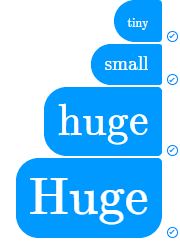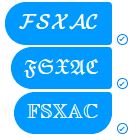Facebook Messenger Formatting Syntax
Updated 2019-05-29
Here is a collection of useful formatting tricks (that’s a clickbait word – it’s more just syntax) that you can use in Facebook’s Messenger app.
Note that for the moment, these syntax seems to be only parsed and rendered in the web-application. This means that this is not going to work on native iOS or Android apps. However it will work in web-app through the mobile browser.
Bold and Brash
Enclose the text in a pair of asterisks ( * ) to make the text bold which helps getting your point to everyone by simulating yelling at them. This works anywhere in your message.

Emphasize Italicize
Enclose the text in a pair of underscores ( _ ) to make the text italic. This works anywhere in your message.

Scratch That
Enclose the text in a pair of tilde symbols ( ~ ) to make the text strikethrough. This works anywhere in your message.

Let’s Speak Code
You can send inline code in Messenger by enclosing text using a pair of backticks ( ` ). This works anywhere in your message.

Let’s Speak More Code
To send code snippets, we can use a pair of triple backticks ( ``` ) which enables multi-line code. Optionally, you can specify the programming language of the code to enable syntax highlighting. (Note: at the time of writing, syntax highlighting was not working.)

Unlike the fore-mentioned formatting syntax, this code block syntax is not as flexible. You shouldn’t mix normal text and code block text in a single message.
Mathematical
We can write blocks of maths blocks by using a pair of double dollar signs ( $$ ). Messenger parses LaTeX syntax using KaTeX, so we have a lot of flexibility. This is especially useful if someone is explaining homework or something to their classmates. Unfortunately, inline maths is not supported. So make sure to keep everything inside the double dollar signs. Like code blocks, don’t mix normal text with maths text, or LaTeX will not render.

Thanks to KaTeX, we can make some crazy LaTeX blocks in Messenger. For example, using \begin{aligned} for aligned multi-line equations. Or using \begin{cases} for cases. And using \begin{bmatrix} for matrices. And much more.
$$
F(x) = \begin{cases}
f(x), & \text{for } 0 \leq x \leq 1 \\
f(x - 1), & \text{for } x > 1 \\
f(x^2 + 1), & \text{for } x < 0
\end{cases}
$$
Turns into

More More LaTeX
LaTeX offers vastly more text formats and styles that what Messenger natively offers. See this Overleaf article on the full extent of LaTeX font customizations. Some notable examples include:
- Set font sizes using
\tiny,\small,\huge,\Huge, etc.

- Set font family using
\textsffor sans serif and\textttfor monospace. - Set mathematical font family using
\mathcal,\mathfrak,\mathbb, etc.

World of Color
While messing around with LaTeX, I also discoved that you can use \color to specify the text color for the LaTeX text.
So something like
$$\text{
\color{#f00}{H}\color{#f94}{e}\color{#ff0}{l}\color{#9f4}{l}\color{#2f2}{o}
\color{#4f9}{W}\color{#0ff}{o}\color{#04f}{r}\color{#40f}{l}\color{#f0f}{d}
}$$
renders into

Combine everything above and we can get some pretty amazing results.
